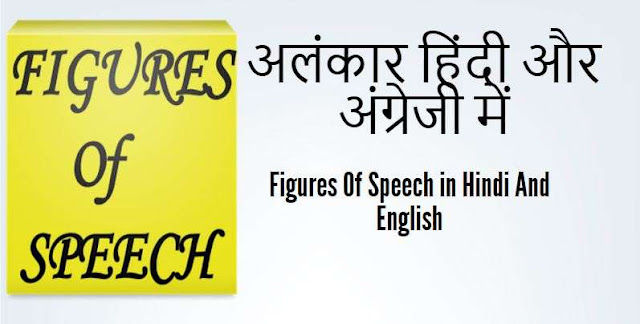अलंकार हिंदी और अंग्रेजी में – Figures Of Speech in Hindi And English
Contents
- 1 अलंकार हिंदी और अंग्रेजी में – Figures Of Speech in Hindi And English
- 1.1 Kinds of Figures of Speech – अलंकार के भेद
- 1.2 Figures of Speech (अलंकार) in English and Hindi
- 1.3 Simile (उपमा – तुलना करना)
- 1.4 Metaphor (रूपक – प्रत्यक्ष तुलना)
- 1.5 Personification (मानवीकरण – निर्जीव वस्तुओं को मानवीय गुण देना)
- 1.6 Hyperbole (अतिशयोक्ति – किसी चीज़ को बढ़ा-चढ़ाकर कहना)
- 1.7 Alliteration (अनुप्रास – एक ही ध्वनि का बार-बार आना)
- 1.8 Onomatopoeia (ध्वन्यात्मकता – किसी ध्वनि की नकल करना)
- 1.9 Oxymoron (विरोधाभास – विपरीत शब्दों का एक साथ प्रयोग)
- 1.10 Irony (व्यंग्य – उल्टा अर्थ प्रकट करना)
- 1.11 Pun (श्लेष – एक शब्द के दो अर्थों का खेल)
- 1.12 Apostrophe (संबोधन – निर्जीव वस्तुओं को बुलाना)
- 1.13 Conclusion
(A Figure of speech is a deprature from the ordinary fron of expression or the ordinary course of ideas in order to produce a greater effect)

अलंकार हिंदी और अंग्रेजी में – Figures Of Speech in Hindi And English
Kinds of Figures of Speech – अलंकार के भेद
- Simile-शिमली – उपमा
- Metaphor- मेटाफर – रूपक
- Personification-परसोनीफिकेशन – मानवीकरण
- Apostrophe- अपोस्ट्रोफी – संबोधन
- Oxymoron- ओक्सिमोरोन – विरोधाभाष
- Onomatopoeia- ओनोमाटोपोइया – ध्वन्यात्मक
- Hyperbole – हाइपरबोल – अतिश्योक्ति
Figures of Speech (अलंकार) in English and Hindi
A Figure of Speech (अलंकार) is a way of expressing ideas in a creative and impactful manner. It makes language more expressive, vivid, and interesting.
Simile (उपमा – तुलना करना)
A simile is a comparison between two different things using “like” or “as”.
Examples:
-
She is as beautiful as a rose. (वह गुलाब की तरह सुंदर है।)
-
He runs like a cheetah. (वह चीते की तरह दौड़ता है।)
Metaphor (रूपक – प्रत्यक्ष तुलना)
A metaphor is a direct comparison without using “like” or “as”.
Examples:
-
Time is money. (समय पैसा है।)
-
He is a lion in the battlefield. (वह युद्ध में शेर है।)
Personification (मानवीकरण – निर्जीव वस्तुओं को मानवीय गुण देना)
It gives human qualities to non-living things.
Examples:
-
The wind whispered through the trees. (हवा ने पेड़ों के बीच फुसफुसाया।)
-
The stars danced in the night sky. (सितारे रात के आकाश में नाचे।)
Hyperbole (अतिशयोक्ति – किसी चीज़ को बढ़ा-चढ़ाकर कहना)
Exaggeration is used to make a point.
Examples:
-
I have told you a million times. (मैंने तुम्हें लाखों बार बताया है।)
-
He is as strong as a mountain. (वह पहाड़ जितना मजबूत है।)
Alliteration (अनुप्रास – एक ही ध्वनि का बार-बार आना)
Repetition of the same consonant sound at the beginning of words.
Examples:
-
She sells seashells by the seashore. (वह समुद्र तट पर सीपियाँ बेचती है।)
-
Peter Piper picked a peck of pickled peppers.
Onomatopoeia (ध्वन्यात्मकता – किसी ध्वनि की नकल करना)
Words that imitate sounds.
Examples:
-
The bees buzzed in the garden. (मधुमक्खियाँ बगीचे में भनभनाईं।)
-
The clock ticked all night. (घड़ी पूरी रात टिक-टिक करती रही।)
Oxymoron (विरोधाभास – विपरीत शब्दों का एक साथ प्रयोग)
Combining two opposite words for effect.
Examples:
-
Bittersweet memories. (मीठी-खट्टी यादें।)
-
Deafening silence. (बहुत तेज़ चुप्पी।)
Irony (व्यंग्य – उल्टा अर्थ प्रकट करना)
Saying something but meaning the opposite.
Examples:
-
Oh great! Another traffic jam. (वाह! फिर से ट्रैफिक जाम!)
-
The fire station burned down. (फायर स्टेशन ही जल गया।)
Pun (श्लेष – एक शब्द के दो अर्थों का खेल)
A play on words with double meanings.
Examples:
-
Time flies like an arrow; fruit flies like a banana.
-
I used to be a baker, but I couldn’t make enough dough.
Apostrophe (संबोधन – निर्जीव वस्तुओं को बुलाना)
Addressing an absent person, object, or idea as if it were alive.
Examples:
-
O death! Where is your sting? (हे मृत्यु! तेरा डंक कहाँ है?)
-
O sun, why do you hide behind the clouds? (हे सूरज, तुम बादलों के पीछे क्यों छिपते हो?)
Conclusion
Figures of Speech make language more expressive, creative, and engaging.
They are used in poetry, literature, speeches, and daily conversations.
Would you like examples from famous poems or literature?
